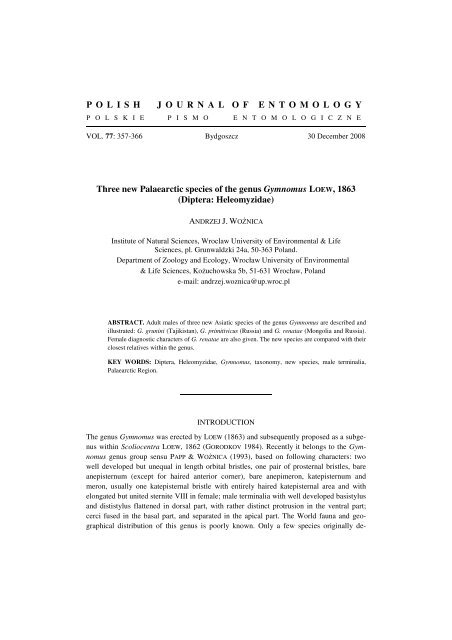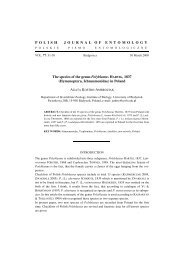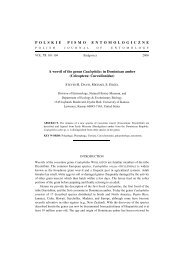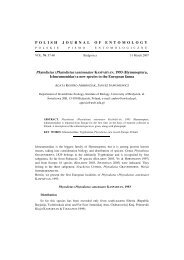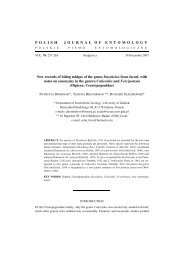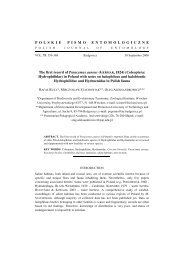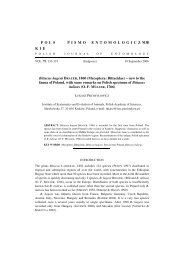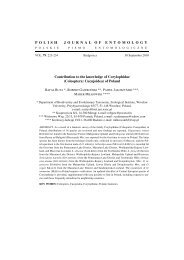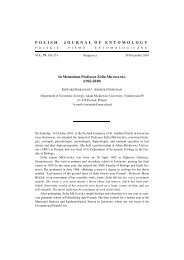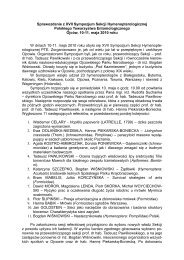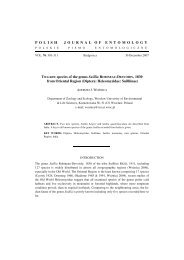WOZNICA A.J. Three new Palaearctic species of the genus ...
WOZNICA A.J. Three new Palaearctic species of the genus ...
WOZNICA A.J. Three new Palaearctic species of the genus ...
You also want an ePaper? Increase the reach of your titles
YUMPU automatically turns print PDFs into web optimized ePapers that Google loves.
P O L I S H J O U R N A L O F E N T O M O L O G Y<br />
P O L S K I E P I S M O E N T O M O L O G I C Z N E<br />
VOL. 77: 357-366 Bydgoszcz 30 December 2008<br />
<strong>Three</strong> <strong>new</strong> <strong>Palaearctic</strong> <strong>species</strong> <strong>of</strong> <strong>the</strong> <strong>genus</strong> Gymnomus LOEW, 1863<br />
(Diptera: Heleomyzidae)<br />
ANDRZEJ J. WOŹNICA<br />
Institute <strong>of</strong> Natural Sciences, Wroclaw University <strong>of</strong> Environmental & Life<br />
Sciences, pl. Grunwaldzki 24a, 50-363 Poland.<br />
Department <strong>of</strong> Zoology and Ecology, Wrocław University <strong>of</strong> Environmental<br />
& Life Sciences, Kożuchowska 5b, 51-631 Wrocław, Poland<br />
e-mail: andrzej.woznica@up.wroc.pl<br />
ABSTRACT. Adult males <strong>of</strong> three <strong>new</strong> Asiatic <strong>species</strong> <strong>of</strong> <strong>the</strong> <strong>genus</strong> Gymnomus are described and<br />
illustrated: G. grunini (Tajikistan), G. primitivicus (Russia) and G. renatae (Mongolia and Russia).<br />
Female diagnostic characters <strong>of</strong> G. renatae are also given. The <strong>new</strong> <strong>species</strong> are compared with <strong>the</strong>ir<br />
closest relatives within <strong>the</strong> <strong>genus</strong>.<br />
KEY WORDS: Diptera, Heleomyzidae, Gymnomus, taxonomy, <strong>new</strong> <strong>species</strong>, male terminalia,<br />
<strong>Palaearctic</strong> Region.<br />
INTRODUCTION<br />
The <strong>genus</strong> Gymnomus was erected by LOEW (1863) and subsequently proposed as a sub<strong>genus</strong><br />
within Scoliocentra LOEW, 1862 (GORODKOV 1984). Recently it belongs to <strong>the</strong> Gymnomus<br />
<strong>genus</strong> group sensu PAPP & WOŹNICA (1993), based on following characters: two<br />
well developed but unequal in length orbital bristles, one pair <strong>of</strong> prosternal bristles, bare<br />
anepisternum (except for haired anterior corner), bare anepimeron, katepisternum and<br />
meron, usually one katepisternal bristle with entirely haired katepisternal area and with<br />
elongated but united sternite VIII in female; male terminalia with well developed basistylus<br />
and dististylus flattened in dorsal part, with ra<strong>the</strong>r distinct protrusion in <strong>the</strong> ventral part;<br />
cerci fused in <strong>the</strong> basal part, and separated in <strong>the</strong> apical part. The World fauna and geographical<br />
distribution <strong>of</strong> this <strong>genus</strong> is poorly known. Only a few <strong>species</strong> originally de-
358 Polish Journal <strong>of</strong> Entomology 77 (4)<br />
scribed in <strong>the</strong> <strong>genus</strong> Amoebaleria CZERNY 1924 were recorded in <strong>the</strong> Nearctic region (GILL<br />
1962). In <strong>the</strong> <strong>Palaearctic</strong>, 16 <strong>species</strong> are known (WOŹNICA 2007), and only 6 were recorded<br />
from Asia so far. In <strong>the</strong> present paper three <strong>new</strong> <strong>species</strong> <strong>of</strong> Gymnomus are described. Gymnomus<br />
grunini is reported from high mountains (Tien Shan Massif), G. primitivicus - in a<br />
Siberian cave and G. renatae - from Russian and Mongolian steppes. In <strong>the</strong> general structure<br />
<strong>of</strong> <strong>the</strong> male terminalia (<strong>the</strong> shape <strong>of</strong> <strong>the</strong> basistylus, dististylus and postgonite), all <strong>the</strong>se<br />
<strong>species</strong> differ distinctly. Gymnomus grunini is similar to G. mongolicus PAPP & WOŹNICA,<br />
1993 regarding external morphological characters. Gymnomus primitivicus is likely closely<br />
related to G. sabroskyi (GILL 1962), widely distributed in <strong>the</strong> mountainous areas <strong>of</strong> <strong>the</strong><br />
Holarctic Region. Gymnomus renatae is similar to <strong>the</strong> G. gorodkovi PAPP & WOŹNICA,<br />
1993, known from Mongolia.<br />
Acknowledgments<br />
I would like to express my sincere thanks to PROF. E. P. NARTSHUK (ZIRANSP, ST.<br />
PETERSBURG, RUSSIA) for loan <strong>of</strong> <strong>the</strong> material presently studied.<br />
MATERIAL AND METHODS<br />
The present work is based on material deposited in Museum <strong>of</strong> <strong>the</strong> Zoological Institute<br />
<strong>of</strong> Russian Academy <strong>of</strong> Sciences, St. Petersburg, Russia (ZIRANSP). The terminalia were<br />
cleared in a solution <strong>of</strong> KOH and placed in a glycerine microvial. The terminology <strong>of</strong> <strong>the</strong><br />
external structures and abbreviations <strong>of</strong> measurements follow those used by WOŹNICA<br />
(2003, 2006). For a better comparison all similar figured structures are magnified to <strong>the</strong><br />
same scale.<br />
TAXONOMY<br />
Gymnomus grunini sp. n.<br />
(Figs 1-4)<br />
Diagnosis<br />
First flagellomere rounded and reddish-brown in colour. Proepimeron with one additional<br />
and minute bristle, and more than twenty thin hairs in <strong>the</strong> anterior corner <strong>of</strong> anepisternum.<br />
Postpronotum totally grey, and hind tibia with one thin dorsolateral bristle.<br />
G. grunini is similar to G. mongolicus but <strong>the</strong> latter <strong>species</strong> differs from <strong>the</strong> <strong>new</strong>ly described<br />
in possessing <strong>the</strong> totally orange first flagellomere, and less than twelve hairs in <strong>the</strong><br />
anterior corner <strong>of</strong> anepisternum, and also in <strong>the</strong> male genitalia.
WOŹNICA A.J.: <strong>Three</strong> <strong>new</strong> <strong>Palaearctic</strong> <strong>species</strong> <strong>of</strong> <strong>the</strong> <strong>genus</strong> Gymnomus 359<br />
Description<br />
Measurements. Body length: big <strong>species</strong>, ca 8.0 mm long.<br />
Head. Head ratio ca 1.3. Anterior part <strong>of</strong> frontal plates yellowish-brown, hind part dark<br />
brown. Eye borders whitish dusted. Ocellar triangle dark brown in colour. One strong vibrissa<br />
with 1-2 small hairs over it. Genal setulae in 2-3 irregular rows. Two strong orbital<br />
bristles, anterior ca 0.70 <strong>of</strong> <strong>the</strong> posterior one. Palpus orange. Proboscis totally dark brown. 2<br />
strong verticals, postverticals smaller in size.<br />
Antenna. Scape and pedicel reddish-orange, first flagellomere slightly elongated, reddish-brown,<br />
and darkened in <strong>the</strong> apical part. Flag-cheek ratio less than 0.50. Arista blackish-brown,<br />
longer than height <strong>of</strong> head. Eye round, face slightly depressed below antennae,<br />
cheek-eye ratio ca 0.80.<br />
Thorax. Mesonotum and pleurae greyish except brownish anterior part <strong>of</strong> anepimeron.<br />
Postpronotum greyish. 1+3 dorsocentral bristles, postsutural bristles emerging from brown,<br />
almost fused stripes. A distinct thin median brownish stripe along <strong>the</strong> dorscocentral bristles<br />
present. Scutellum brownish, slightly greyish dusted dorsally. Postscutellum greyish.<br />
Proepimeron with one strong and one small additional bristles. Anterior corner <strong>of</strong> anepisternum<br />
covered by more than 20 thin hairs. Katepisternum grey and densely covered by<br />
fine hairs, and with one strong bristle only.<br />
Wings. Length 8.20 mm, width 2.95 mm. Membrane transparent, cross veins not darkened.<br />
Costal spines distinct, longer than width <strong>of</strong> <strong>the</strong> costa. Veins yellowish-brown. Medial<br />
vein ratio ca 1.18. Halters yellowish.<br />
Legs. Yellowish-brown, covered by relatively long and dense hairs. Fore femur greyish<br />
anterodorsally, and with one row <strong>of</strong> anterodorsal and posteroventral bristles. Hind femur<br />
with one thin dorsolateral bristle. All tibia covered by long thin hairs (<strong>the</strong> length <strong>of</strong> it<br />
greater than width <strong>of</strong> <strong>the</strong> tibia). First and second tarsomere <strong>of</strong> mid leg long haired. First and<br />
second tarsomere <strong>of</strong> hind leg at <strong>the</strong> same size. <strong>Three</strong> last tarsomeres <strong>of</strong> all legs dark brown.<br />
Abdomen. All tergites grey covered by long and thin hairs and with thin long marginal<br />
bristles.<br />
Male terminalia. Epandrium relatively big and slightly elongated. Cerci leng<strong>the</strong>ned and<br />
broadened in <strong>the</strong> middle (Fig. 1). Basistylus long and slightly curved in <strong>the</strong> apical part (Fig.<br />
3), dististylus as in fig. 4. Postgonite broad and with two bristles, <strong>the</strong> lower is less than 1/2<br />
<strong>of</strong> <strong>the</strong> length <strong>of</strong> <strong>the</strong> upper one (Fig. 2). Hypandrium with three lateral bristles. Distiphallus<br />
banded and slightly twisted and not haired.<br />
Type Material<br />
Holotype, ♂, Tajikistan, Gisearskiy hr., Anzobskiy pereval, 3400m, Grunin,<br />
27.6.[1]956 (ZIRANSP).<br />
Distribution. Asiatic, East-<strong>Palaearctic</strong> <strong>species</strong>. Probably a high mountainous <strong>species</strong><br />
with unknown biology.
360 Polish Journal <strong>of</strong> Entomology 77 (4)<br />
Figs 1-4. Gymnomus grunini sp. n. 1-4, male terminalia: 1 – cerci, 2- postgonite laterally,<br />
3 – basistylus laterally, 4 – dististylus laterally.
WOŹNICA A.J.: <strong>Three</strong> <strong>new</strong> <strong>Palaearctic</strong> <strong>species</strong> <strong>of</strong> <strong>the</strong> <strong>genus</strong> Gymnomus 361<br />
Etymology<br />
The name is dedicated to <strong>the</strong> late DR. Konstantin YAKOVLEVICH GRUNIN, <strong>the</strong> collector<br />
<strong>of</strong> <strong>the</strong> <strong>species</strong> and specialist on parasitic Calyptrate flies.<br />
Gymnomus primitivicus sp. nov.<br />
(Figs 5-8)<br />
Scoliocentra sp. n: GORODKOV, 1977: 84 (Russia).<br />
Diagnosis<br />
G. primitivicus differs from all known Gymnomus <strong>species</strong> in having one additional bristle<br />
behind <strong>the</strong> big vibrissa, and in <strong>the</strong> structures <strong>of</strong> male terminalia.<br />
Description<br />
Measurements. Body length (without antennae) varies from 5.5 mm to 5.8 mm.<br />
Head. Head ratio ca 1.17. Anterior part <strong>of</strong> frontal plate yellowish-orange, posterior<br />
part brownish in colour. Ocellar triangle dark, brownish-black. One strong vibrissa with<br />
additional medium sized bristle behind <strong>of</strong> it. Genal setulae strongly developed in one irregular<br />
row. Two well developed orbital bristles, anterior distinctly smaller than <strong>the</strong> posterior<br />
one. Palpus dark orange. Proboscis regularly brown in colour. Two strong verticals,<br />
postvertical cruciate and smaller than verticals.<br />
Antenna. First flagellomere missing, but with all probability big, scape and pedicel orange<br />
in colour. Eye rounded, face below antennal grooves slightly depressed, cheek-eye<br />
ratio ca 0.42-0.49.<br />
Thorax. Mesonotum greyish, pleura grey except yellowish-brown postpronotum and<br />
anterior anepimeral part. Dorsal part covered by thick blackish setulae. Scutellum greyishbrown<br />
but darkened at <strong>the</strong> base and on <strong>the</strong> lateral borders. Dorsal part <strong>of</strong> postscutellum<br />
totally grey, ventral part brownish in colour. Chaetotaxy: 1 + 3 dorsocentral bristles with<br />
well developed pair <strong>of</strong> prescutellars. Anterior part <strong>of</strong> anepisternum covered by several<br />
blackish hairs (one is setula-like and distinctly longer from all o<strong>the</strong>r). Katepisternum with<br />
one distinct katepisternal bristle.<br />
Legs. Pale orange in colour, stocky, and shortly haired only. Fore femur greyish dusted<br />
anteriorly, mid and hind femora with dorsolateral bristles. Mid femur with two rows <strong>of</strong><br />
strong anterodorsal bristles, hind femur with 1-2 dorsolateral bristles. <strong>Three</strong> last tarsomeres<br />
<strong>of</strong> fore and hind tarsi, and last two <strong>of</strong> mid tarsus dark, blackish-brown in colour. Two rows<br />
<strong>of</strong> distinct internal black spines on first tarsomere <strong>of</strong> mid leg. First tarsomere <strong>of</strong> hind leg<br />
slightly longer than <strong>the</strong> second one and with distinct tooth-like spine.
362 Polish Journal <strong>of</strong> Entomology 77 (4)<br />
Wings. Length 5.90-5.95 mm, width ca 2.15 mm. Membrane transparent, cross veins<br />
not darkened. Costal spines well developed, big and strong, and longer than width <strong>of</strong> <strong>the</strong><br />
costa. All veins pale brown in colour. Medial vein ratio ca 1.11-1.13. Halters yellow.<br />
Abdomen. Tergites reddish-orange, short haired, marginal bristles <strong>of</strong> segments III-V<br />
distinctly longer than length <strong>of</strong> segments.<br />
Figs 5-8. Gymnomus primitivicus sp. n. 5-8, male terminalia: 5 – cerci, 6 – postgonites laterally,<br />
7 – basistylus laterally, 8 – dististylus laterally.
WOŹNICA A.J.: <strong>Three</strong> <strong>new</strong> <strong>Palaearctic</strong> <strong>species</strong> <strong>of</strong> <strong>the</strong> <strong>genus</strong> Gymnomus 363<br />
Male terminalia. Epandrium round shaped and ra<strong>the</strong>r small in size, covered by long<br />
black hairs Cerci relatively small but wide, flattened and broadened in <strong>the</strong> apical part (Fig.<br />
5). Basistylus much broader than dististylus and with dense black thorns on both sides (Fig.<br />
7). Dististylus narrowed, shaped like an inverted V, in lateral view, and with left distal part<br />
(lateral lobe) distinctly extended (Fig. 8). The medial lobe with a projecting process with<br />
black thorns grouped in <strong>the</strong> apex. Postgonite shorter than high, apically sharpened, with two<br />
strong bristle, <strong>the</strong> lower (first) distinctly shorter than <strong>the</strong> upper one (ca 0.6x) (Fig. 6).<br />
Female. Unknown.<br />
Type Material<br />
Holotype: ♂, Russia, Barsuchya peshchera, okr. Krasnoyarska, N. Ovodov, 7.VI.[1]965<br />
(ZIRANSP): Paratype: ♂, Barsuchya peshchera, okr. Krasnoyarska, N. Ovodov,<br />
7.VI.[1]965 (ZIRANSP).<br />
Remarks<br />
The most primitive Gymnomus <strong>species</strong>, with haired basiphallus and short but broad basistylus.<br />
It is similar to G. sabroskyi (GILL, 1962) basing on <strong>the</strong> male terminalia.<br />
Distribution. East <strong>Palaearctic</strong> <strong>species</strong>.<br />
Biology. Unknown, probably a troglophilous <strong>species</strong> found in cave.<br />
Etymology<br />
The name primitivicus (=primitive) refers to <strong>the</strong> primal structures <strong>of</strong> male terminalia.<br />
Gymnomus renatae sp. n.<br />
(Figs 9-14)<br />
Scoliocentra (Amoebaleria) ventricosa (not BECKER, 1907): Gorodkov, 1972: 896 (Mongolia).<br />
Diagnosis<br />
Dark brown first flagellomere, yellow postpronotum, anepisternum with several hairs<br />
in <strong>the</strong> anterior corner and hind femur with one dorsolateral bristle only distinguish this<br />
<strong>species</strong> from o<strong>the</strong>r known Gymnomus <strong>species</strong>.<br />
Description<br />
Measurements. Body length: 7.95 mm - 9.05 mm. Head ratio varies from 1.20 to 1.25.
364 Polish Journal <strong>of</strong> Entomology 77 (4)<br />
Head. Anterior part <strong>of</strong> frontal plate, reaching to first orbital bristle orange, remaining<br />
part brownish. Face brownish, and silver dusted like gena and eye border area. Anterior<br />
orbital bristle ca 0.60-0.70x <strong>of</strong> <strong>the</strong> posterior one. Genal setulae in 3-4 irregular rows.<br />
Antenna. Scape and pedicel intensively orange, first flagellomere brownish-orange,<br />
slightly elongated, and more darkened at apex. Cheek-eye ratio varies from 0.75 to 0.82,<br />
flag-cheek ratio ca 0.45.<br />
Thorax. Mesonotum greyish-brown, postpronotum yellowish to dirty yellow. Notopleural<br />
areas and upper part <strong>of</strong> katepisternum near katepisternal bristle similarly coloured.<br />
Proepisternum and hind metasternal part yellowish-brown in colour. Anterior part <strong>of</strong> anepisternum<br />
covered with 20 to 25 hairs. Scutellum yellowish-brown, sometimes dorsum<br />
greyish dusted. Postscutellum greyish. Dorsocentral bristles arising from small blackishbrown<br />
dots.<br />
Wings. Length: 8.00 mm - 9.50 mm, width: 2.80 mm - 3.10 mm. Medial vein ratio:<br />
1.06-1.09. Costal spines well developed and distinctly greater than width <strong>of</strong> <strong>the</strong> costa.<br />
Membrane slightly yellowish tinged. Halters yellowish-brown in colour.<br />
Legs. Yellowish-brown in colour. Fore femur greyish dusted anteriorly. Mid femur<br />
with two rows <strong>of</strong> few strong anterodorsal bristles placed in <strong>the</strong> subapical part. Hind femur<br />
with one dorsolateral bristle. All femora and tibiae, with exception <strong>of</strong> basal part <strong>of</strong> mid<br />
tibia, distinctly long haired. All tarsomeres brownish, especially in <strong>the</strong> apical part. First<br />
tarsomere <strong>of</strong> mid leg long haired.<br />
Abdomen. Male segments I-IV greyish with ra<strong>the</strong>r thick and distinct marginal bristles.<br />
Segment V and epandrium brownish-grey. In <strong>the</strong> female hind half <strong>of</strong> segment V and remaining<br />
yellowish-brown in colour.<br />
Male terminalia. Cerci elongated and long haired (Fig. 9). The separated apical part<br />
more longer than 1/2 <strong>of</strong> total <strong>the</strong> length <strong>of</strong> it. Apical part slightly narrowed and blunted at<br />
apex. Basistylus middle sized, with wide and rounded apex, covered by several thorns (Fig.<br />
11). Dististylus distinctive: lateral lobe strongly narrowed, extended apically, inner apical<br />
part with few distinct thorns only. Medial lobe narrowed and knob-like apically, and covered<br />
with several thorns (Fig. 12). Postgonite short, lower bristle distinctly shorter than <strong>the</strong><br />
upper one (more than half <strong>of</strong> <strong>the</strong> longer one) (Fig. 10). Hypandrium U-shaped, well sclerotized<br />
and with three bristles on lateral sides. Thin and long distiphallus is slightly twisted<br />
only. The base <strong>of</strong> basiphallus bears two small lobed appendices.<br />
Female terminalia. Sternite VIII tear-shaped (Fig. 13), spermathaece round and smooth<br />
as in fig. 14.
WOŹNICA A.J.: <strong>Three</strong> <strong>new</strong> <strong>Palaearctic</strong> <strong>species</strong> <strong>of</strong> <strong>the</strong> <strong>genus</strong> Gymnomus 365<br />
Figs 9-14. Gymnomus renatae sp. n. 9-12, male terminalia: 9 – cerci, 10- postgonite lasterally, 11 –<br />
basistylus laterally, 12 – dististylus laterally. 13-14, female diagnostic characters: 13 - VIIIth sternite,<br />
14 – sperma<strong>the</strong>cae.
366 Polish Journal <strong>of</strong> Entomology 77 (4)<br />
Type Material<br />
Holotype, ♂, Barguzinskiye stepi, Zabaykale, Zarubina, VIII-IX. 1957, Iz gnezd tarbagana<br />
(ZIRANSP). Paratypes, 8♂♂6♀♀, Barguzinskiye stepi, Zabaykale, Zarubina, VIII-<br />
IX. 1957 (2♂♂1♀ in author coll., o<strong>the</strong>r to ZIRANSP): 1♂, Bichikte-Mishigun, Halha,<br />
Mong., Kozlov 1-7.IX.[1]925; Amoebaleria ventricosa BECK. det. CZERNY (ZIRANSP).<br />
1♂, Mongolia, Vost.-Gob., aimak, g. Caentael-Obo, Kerzhner 11. VI. [1]971(ZIRANSP).<br />
Distribution. An Asiatic <strong>species</strong> known from Mongolia and Sou<strong>the</strong>rn part <strong>of</strong> Russia,<br />
probably widely distributed in <strong>the</strong> steppe zones.<br />
Biology. Reared from larvae developed in excrements <strong>of</strong> Marmota sibirica (RADDE).<br />
Etymology<br />
The <strong>species</strong> name is dedicated to my wife RENATA ZOFIA, who over <strong>the</strong> years has graciously<br />
provided encouragement and constant support <strong>of</strong> my work on <strong>the</strong> Heleomyzidae.<br />
REFERENCES<br />
CZERNY L. 1924. Monographie der Helomyziden, Abhandl. Zool.-Bot. Ges. Wien, 15(1): 1-166.<br />
GILL G. D. 1962. The Heleomyzid flies <strong>of</strong> America north <strong>of</strong> Mexico (Diptera: Heleomyzidae. Proc.<br />
U.S. natn. Mus. 113(3465): 495-603.<br />
GORODKOV K. B. 1962. Revision <strong>of</strong> <strong>the</strong> <strong>Palaearctic</strong> <strong>species</strong> <strong>of</strong> <strong>the</strong> <strong>genus</strong> Leria R.D. (Diptera, Helomyzidae).<br />
Ent. obozr. 41(3): 643-671 (in Russian).<br />
GORODKOV K. B. 1972. On <strong>the</strong> fauna <strong>of</strong> Helomyzidae (Diptera) <strong>of</strong> <strong>the</strong> Mongolian People's Republic.<br />
[in:] Nasekomye Mongolii. 1: 887-904 (in Russian).<br />
GORODKOV K. B. 1977. Dvukrylye semejstva Helomyzidae (Diptera) zapovednika >. Trudy<br />
Gos. Zap. >. 11: 81-86.<br />
GORODKOV K. B. 1984. Family Heleomyzidae (Helomyzidae). [in:] Á. SOÓS & L. PAPP (eds.).<br />
LOEW H. 1863. Gymnomus troglodytes, eine neue österreichische Fliegengattung. Wien. ent. Mschr.<br />
7(2): 36-38.<br />
PAPP L. & WOŹNICA A. 1993. A revision <strong>of</strong> <strong>the</strong> <strong>Palaearctic</strong> <strong>species</strong> <strong>of</strong> Gymnomus LOEW (Diptera:<br />
Heleomyzidae). Acta Zoologica Hungarica. 39(1-4): 175-210.<br />
WOŹNICA A. 2003. Two <strong>new</strong> synonyms <strong>of</strong> <strong>the</strong> Old World representatives <strong>of</strong> <strong>the</strong> <strong>genus</strong> Suillia<br />
Robineau-Desvoidy, 1830 (Diptera: Heleomyzidae: Suilliinae). Pol. Pismo Entomol. 72: 349-357.<br />
WOŹNICA A. 2006. <strong>Three</strong> <strong>new</strong> <strong>species</strong> <strong>of</strong> <strong>the</strong> <strong>genus</strong> Suillia ROBINEAU-DESVOIDY, 1830 from <strong>the</strong><br />
Neotropical Region (Diptera: Heleomyzidae). Annales Zoologici. 56: 657-665.<br />
WOŹNICA A. 2007. Two <strong>new</strong> <strong>species</strong> <strong>of</strong> <strong>the</strong> <strong>genus</strong> Gymnomus LOEW from Asia (Diptera: Heleomyzidae).<br />
Genus. 18(4): 777-782.<br />
Received: November 15, 2008<br />
Accepted: November 24, 2008


